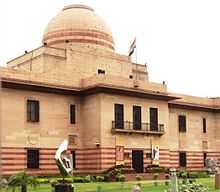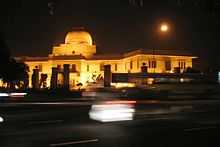Jaipur House


Jaipur House is the former residence of the Maharaja of Jaipur in Delhi.
It situated at the end of Rajpath, facing the India Gate. It was designed by Sir Arthur Bloomfield, after the construction of Lutyens' Delhi, in 1936.[1][2]
The structure has a butterfly layout and a central dome. The structure is clad in red and yellow sandstone. To the back of the palace is a large garden, which can be entered through the main ballroom on the ground floor. The ballroom is panelled in dark wood.
Inside is the main hall underneath the central dome, with a large spiral staircase leading to the upper floor.
Today it houses the National Gallery of Modern Art (NGMA), India's premier art gallery which was established here by Ministry of Culture in 1954. [2]
See also
References
- ↑ Sharma, Manoj (2011-06-08). "Of princes, palaces and plush points". Hindustan Times. Retrieved 13 December 2013.
- ↑ 2.0 2.1 History NGMA website
External links
![]() Media related to Jaipur House at Wikimedia Commons
Media related to Jaipur House at Wikimedia Commons